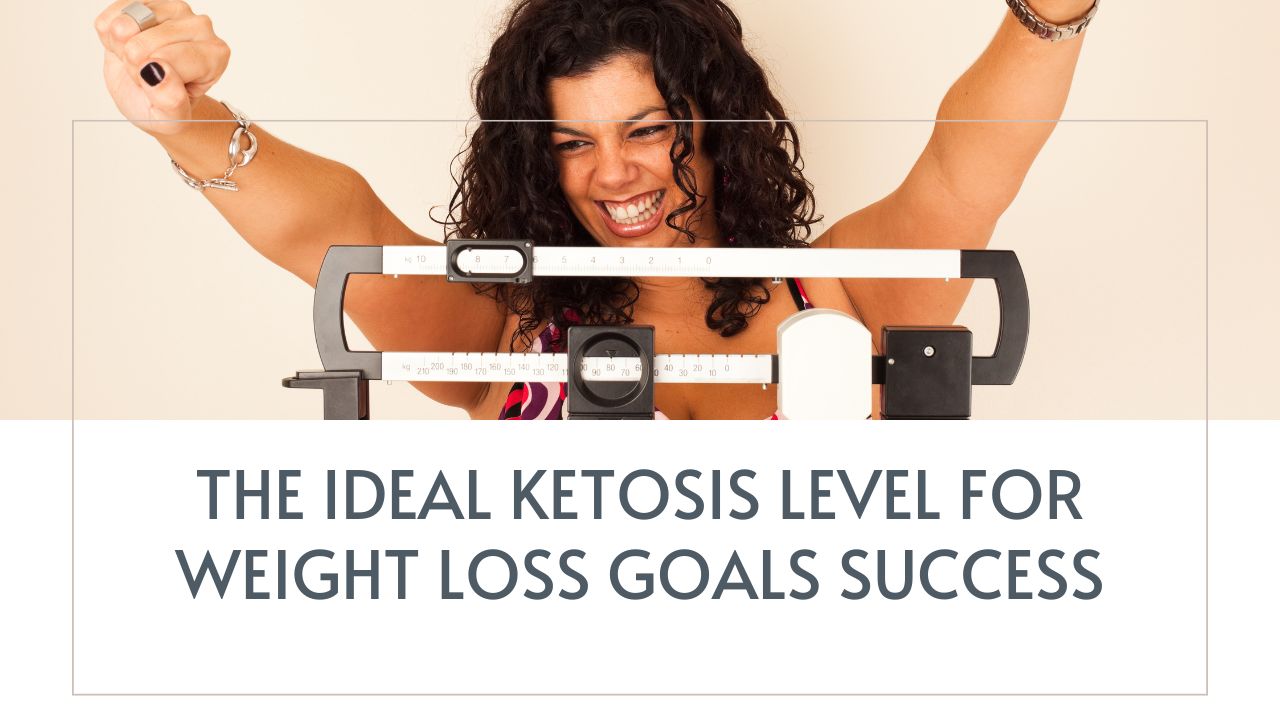Curious about the ideal ketosis level for weight loss? Wondering how to measure and track it? Let’s answer all your questions in this informative guide.

Are you looking to shed those extra pounds and achieve your weight loss goals? If so, understanding the concept of ketosis and its role in weight loss is crucial.
Ketosis is a natural metabolic state where your body shifts from using carbohydrates as its primary source of energy to burning fat instead. But what is the ideal ketosis level for weight loss?
In this blog, we will delve into the science behind ketosis, explain how it aids in weight loss, and provide insights on achieving and maintaining the ideal ketosis level for maximum results.
Get ready to embark on your weight loss journey with a deeper understanding of the power of ketosis.
Different levels of ketosis and their effects on weight loss
Understanding the different levels of ketosis and their effects on weight loss can help you tailor your approach to maximize results.
First Level of Ketosis
The first level of ketosis is the mild ketosis stage. This is where the body starts producing ketones and transitioning from using glucose as its primary fuel source.
In this stage, weight loss can occur at a moderate pace. However, it’s important to note that the body may still rely partially on carbohydrates, so achieving consistent weight loss may require stricter adherence to the ketogenic diet.
Moderate Level of Ketosis
Moving on to the moderate ketosis stage, the body becomes more efficient in utilizing fat for energy. This results in a more rapid weight loss compared to mild ketosis.
With reduced carbohydrate intake and increased fat consumption, the body is forced to rely on stored fat for fuel. This stage is often associated with increased mental clarity and improved energy levels, making it easier to maintain the diet and adhere to your weight loss goals.
Final Level of Ketosis
The final level of ketosis is known as deep ketosis. At this stage, the body is fully adapted to burning fat for energy and has significantly decreased its reliance on carbohydrates.
This level of ketosis is associated with accelerated weight loss and increased metabolic efficiency. However, it’s important to approach deep ketosis with caution and under the guidance of a healthcare professional, as it can lead to potential side effects and may not be suitable for everyone.
Ultimately, the ideal ketosis level for weight loss varies from person to person. It’s important to listen to your body and adjust your approach accordingly.
Regular monitoring of ketone levels through blood, urine, or breath tests can provide valuable insights into your progress and help you fine-tune your diet and lifestyle choices.
Sustainable weight loss is a journey, and finding the right level of ketosis for your body is key to achieving your goals.
How to measure and track your ketosis level
Measuring and tracking your ketosis level is essential when following a ketogenic diet for weight loss. By understanding and monitoring your ketosis level, you can ensure that your body is effectively transitioning into a state of fat-burning for energy.
Here are some reliable methods to measure and track your ketosis level:
1. Ketone Urine Test Strips
One of the most common and affordable ways to measure ketosis is through urine test strips. These strips detect the presence of ketones in your urine, indicating whether your body is in ketosis or not.
Simply urinate on the strip and wait for the color change to determine your ketosis level.
2. Blood Ketone Meter
For more accurate results, a blood ketone meter is highly recommended. This device measures the actual ketone levels in your blood and provides a precise reading of your ketosis level.
Although more expensive than urine test strips, blood ketone meters offer reliable and instant feedback.
3. Breath Ketone Analyzer
Another non-invasive method is using a breath ketone analyzer. This device measures the acetone levels in your breath, which correlates to the ketones produced by your body. These analyzers are portable, easy to use, and offer real-time results.
Regardless of the method you choose, consistency is key when tracking your ketosis level. Make a habit of measuring at the same time each day to ensure accurate comparisons.
Additionally, keep in mind that the ideal ketosis level for weight loss varies between individuals. Generally, a range of 0.5 to 3.0 millimoles per liter (mmol/L) is considered optimal for fat-burning and weight loss.
By regularly measuring and tracking your ketosis level, you can gauge your progress, make necessary adjustments to your diet and lifestyle, and stay motivated on your weight loss journey.
Always consult with a healthcare professional or nutritionist to personalize your approach and ensure a safe and effective ketogenic experience.
Finding your ideal ketosis level for weight loss
To determine your ideal ketosis level, you need to measure your ketone levels. There are several methods to do this, including urine strips, blood tests, and breath analyzers.
These tools measure the presence of ketones in your body, indicating the level of ketosis you’re in. However, it’s important to note that there is no one-size-fits-all approach when it comes to ketosis levels for weight loss.
Each individual’s metabolism and body composition are unique, which means that your ideal ketosis level may differ from others. Factors such as age, activity level, and overall health also play a role in determining the right level for you.
To find your ideal ketosis level, it’s recommended to start with a moderate approach. Aim for a range of 0.5 to 3.0 millimoles per liter (mmol/L) of ketones in your blood.
This level is considered to be a good starting point for weight loss benefits while still maintaining energy levels and overall well-being. Monitoring your ketone levels regularly is essential to assess if you’re in the right range.
If your ketosis level is below 0.5 mmol/L, you may need to adjust your diet to increase your fat intake and decrease your carbohydrate intake.
On the other hand, if your ketosis level exceeds 3.0 mmol/L, you might want to moderate your fat intake to prevent excessive ketone production. It’s important to find a balance that works for your body and goals.
Consulting with a healthcare professional or a registered dietitian who specializes in ketogenic diets can provide valuable guidance in determining your ideal ketosis level for effective weight loss.
Achieving and maintaining ketosis requires consistency and dedication. Finding your ideal ketosis level is just one piece of the puzzle, but it can significantly impact your weight loss journey on a ketogenic diet.
Tips for reaching and maintaining your ideal ketosis level
Reaching and maintaining the ideal ketosis level is crucial for those who are following a ketogenic diet for weight loss.
To successfully achieve and sustain this state, here are some effective tips to consider:
1. Limit Carbohydrate Intake
To induce ketosis, it is essential to minimize carbohydrate consumption. Keeping your carb intake below 50 grams per day, or even as low as 20-30 grams, can help kickstart ketosis. Focus on consuming low-carb, high-fat foods such as avocados, nuts, and fatty cuts of meat.
2. Adequate Protein Intake
While protein is an important macronutrient, excessive consumption can potentially hinder ketosis. It is crucial to consume an adequate amount of protein to preserve muscle mass, but not too much so that it gets converted into glucose through a process called gluconeogenesis. Consult with a nutritionist or use online calculators to determine your protein requirements.
3. Embrace Healthy Fats
A ketogenic diet is characterized by high fat intake. Incorporate healthy fats such as coconut oil, olive oil, and grass-fed butter into your meals. These fats not only provide satiety but also aid in the production of ketones.
4. Stay Hydrated
Adequate hydration is essential for overall health and to support ketosis. Drink plenty of water throughout the day to prevent dehydration. This is particularly crucial as ketosis can have a diuretic effect, leading to increased water loss.
5. Monitor Ketone Levels
Utilizing ketone testing tools such as urine strips, blood meters, or breath analyzers can provide valuable insights into your ketosis level. Regularly monitoring ketone levels can help you adjust your diet and ensure you stay within the optimal range.
6. Be Mindful of Hidden Carbohydrates
Carbohydrates can hide in unexpected places, such as sauces, condiments, and processed foods. Read nutrition labels carefully, and aim to consume whole, unprocessed foods to minimize hidden carbs and maximize the benefits of ketosis.
By implementing these tips into your ketogenic lifestyle, you can increase your chances of reaching and maintaining the ideal ketosis level for weight loss.
Consistency and personalization are key to achieving your desired results!
Do you know your level of ketosis?
Understanding and achieving the ideal ketosis level can be a game-changer in your weight loss journey. By following the guidelines and tips I’ve mentioned, you can optimize your body’s fat-burning potential and accelerate your progress toward your weight loss goals.
Remember, consistency and patience are key as your body adapts to this new metabolic state.
Here’s to a successful and fulfilling weight loss journey!
More Keto articles to read:


Thank you for sharing this informative article about ketosis. You provided valuable insights.
You’re welcome, Zoey! Thank you for taking the time to read my post. Good luck on your weight loss journey.